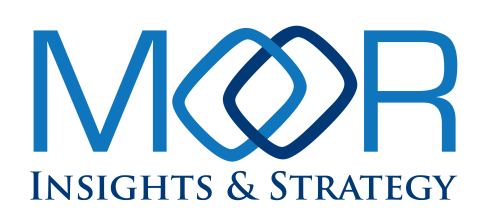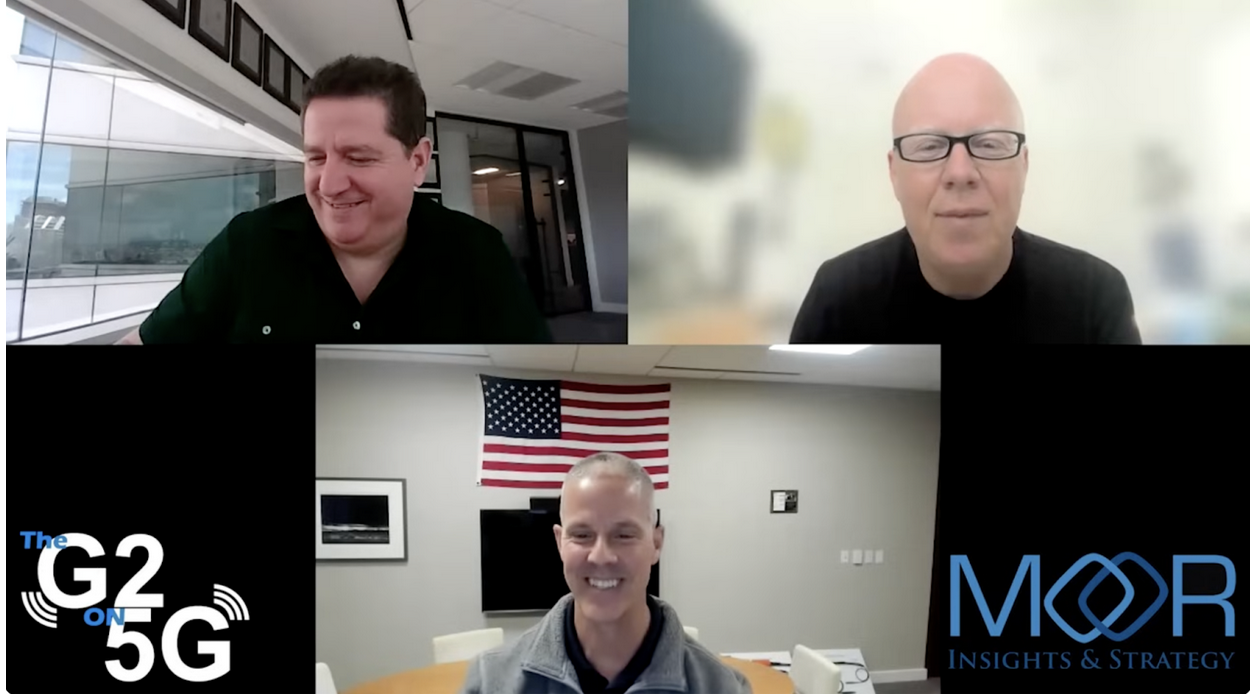
Welcome to this week’s edition of the Moor Insights & Strategy analyst insights roundup. Conference season is heating up, which means we are crisscrossing the country to see and hear the latest from Microsoft, SAP, Teradata, and more, on top of our usual briefings and advisory sessions. If you’re wondering where we’ll be, check out the event listing toward the bottom of this update — and please don’t hesitate to reach out if you’d like to book a meeting, or just to arrange a face-to-face hello.
This week, we’re going to start you off with AST SpaceMobile’s satellite telecom technology before we take our usual tour of the many industry segments we cover. Enjoy!
Last week, Will Townsend (with content partner and podcast editor Anshel Sag behind the scenes) hosted Chris Sambar, president of Network for AT&T, and Abel Avellan, CEO at AST SpaceMobile, for a standalone “G2 on 5G” podcast: AT&T and AST SpaceMobile’s Vision to Bridge the Digital Divide.
Get a front-row view into the vision for a world where broadband connectivity is accessible to everyone, everywhere, through a revolutionary network of large satellites. Discover how AST SpaceMobile is pushing the boundaries of space-based connectivity, aiming to bridge the digital divide and bring high-speed internet access to even the most remote corners of the globe.
Don’t miss this opportunity to hear from true visionaries in the field!
This week, Robert will be at the Infor Annual Summit in Las Vegas, and LogicMonitor’s event in Austin. Melody will be attending the Fem.AI Summit in Menlo Park, and Microsoft’s Industry Analyst Event in Burlington, Massachusetts.
Last week, Patrick and Anshel attended HP Imagine in Palo Alto while Melody attended virtually. Anshel also traveled to San Jose for Meta Connect, and Melody attended Verint Engage in Orlando and SAP CX Live virtually.
Our team will be busy next week! Robert will be in Los Angeles at Teradata. Melody will be attending SAP’s TechEd event virtually and in San Jose for Zoomtopia. Bill will be in Austin for Embedded World NA. Will is attending the MWC Americas and serving as a judge for the T-Mobile for Business Unconventional Awards event in Las Vegas. Matt will be in San Francisco for AMD’s event, and Jason and Robert are attending the AWS GenAI Summit in Seattle. Stay tuned for updates from all of those exciting events!
Our MI&S team published 23 deliverables:
- 4 Forbes Articles
- 1 Research Paper
- 2 MI&S Research Notes
- 3 MI&S Blog Posts
- 13 Podcasts
Over the last week, our analysts have been quoted multiple times in top-tier international publications with our thoughts on Apple, Box, HP, Hybrid Cloud Infrastructure, IBM, Infoblox, Intel, Meta, and Pure Storage.
MI&S Quick Insights
This week I published a primer on AI agents. This is already an area of intense activity for many of our clients which I believe is ushering in a new generation of AI capabilities in the enterprise. As opposed to training an AI model, an agent actually constrains it to follow a specific set of rules or processes. While that may sound limiting, it’s actually the opposite because it allows an enterprise to dictate aspects of how it wants AI to behave and execute a process. That’s important because then a business can figure out and measure the business impact that AI will provide. ROI is still the key to all technology decisions in the business world, and agents may be the key to building an ROI-centric narrative.
One of my favorite things about IBM is how committed it has been to open source. That commitment is demonstrated by mountains of contributions before and after acquiring Red Hat. Eclipse, Tomcat, and Redshift are all examples of how IBM has contributed to open source in a non-commercial way for the benefit of the entire industry. This week I took a look at AI Fairness 360, which IBM recently committed to the Linux Foundation’s LF AI projects. It’s an open source toolkit designed to help place better guardrails on bias and hate speech. It’s intriguing for three key reasons. First, it’s open source so anyone can contribute and use it, which provides a common shareable platform for this important aspect of AI. Second, it goes beyond words by using over 70 fairness metrics to understand if there is bias in underlying machine learning processes like credit scoring or fraud detection. And third, unlike a lot of AI tech, it’s not a black box, which means that its workings are open to public scrutiny. This should be a welcome aspect for privacy advocates. While many companies—such as AWS with its Bedrock Guardrails service—are also doing work in this area, the notion of a common cross-industry capability is quite interesting.
Recently, CodeSignal released one of the most interesting AI developer benchmark studies that I have seen. Like many great studies, it not only informs the reader but also prompts more questions for further research. CodeSignal sells a skills framework that many enterprises use to evaluate developers during the hiring process. The company now has more than 500,000 test results, so it has a very good feel for a wide range of developers and their relative skills. Now CodeSignal has let a bunch of different LLMs take the test to see what happened. I have a piece on this coming out next week, but the two big takeaways are that (1) AI is keeping up pretty well with humans and (2) the selection of LLM has a big impact on the results. Stay tuned for more on this one.
This week I published a primer on AI agents. This is already an area of intense activity for many of our clients which I believe is ushering in a new generation of AI capabilities in the enterprise. As opposed to training an AI model, an agent actually constrains it to follow a specific set of rules or processes. While that may sound limiting, it’s actually the opposite because it allows an enterprise to dictate aspects of how it wants AI to behave and execute a process. That’s important because then a business can figure out and measure the business impact that AI will provide. ROI is still the key to all technology decisions in the business world, and agents may be the key to building an ROI-centric narrative.
One of my favorite things about IBM is how committed it has been to open source. That commitment is demonstrated by mountains of contributions before and after acquiring Red Hat. Eclipse, Tomcat, and Redshift are all examples of how IBM has contributed to open source in a non-commercial way for the benefit of the entire industry. This week I took a look at AI Fairness 360, which IBM recently committed to the Linux Foundation’s LF AI projects. It’s an open source toolkit designed to help place better guardrails on bias and hate speech. It’s intriguing for three key reasons. First, it’s open source so anyone can contribute and use it, which provides a common shareable platform for this important aspect of AI. Second, it goes beyond words by using over 70 fairness metrics to understand if there is bias in underlying machine learning processes like credit scoring or fraud detection. And third, unlike a lot of AI tech, it’s not a black box, which means that its workings are open to public scrutiny. This should be a welcome aspect for privacy advocates. While many companies—such as AWS with its Bedrock Guardrails service—are also doing work in this area, the notion of a common cross-industry capability is quite interesting.
Recently, CodeSignal released one of the most interesting AI developer benchmark studies that I have seen. Like many great studies, it not only informs the reader but also prompts more questions for further research. CodeSignal sells a skills framework that many enterprises use to evaluate developers during the hiring process. The company now has more than 500,000 test results, so it has a very good feel for a wide range of developers and their relative skills. Now CodeSignal has let a bunch of different LLMs take the test to see what happened. I have a piece on this coming out next week, but the two big takeaways are that (1) AI is keeping up pretty well with humans and (2) the selection of LLM has a big impact on the results. Stay tuned for more on this one.
Meta AI announced the Llama 3.2 model with new 1B and 3B model sizes, which will be absolutely crucial for wearables and other consumer products that want to leverage LLMs but don’t have the memory or processing footprint to run 70B- or 90B-parameter models. The company also announced an 11B multi-modal version of Llama 3.2, which Qualcomm says it already has running on its latest smartphone SoC. For the 1B and 3B models, Meta has already qualified the model with Arm, Qualcomm, and MediaTek.
It may seem too early to replace a CEO with an AI model, but three Harvard professors ran an experiment along those lines that involved 344 students and executives versus GPT-4o, a new LLM from OpenAI. In the simulation of the U.S. automotive industry, the people made strategic decisions that spanned several simulated years. The objectives were to maximize the company’s market cap and to remain employed.
GPT-4o performed well on most metrics and efficiently responded to the market by designing products. However, the model didn’t respond well to “black swan” events. That failure caused the AI CEOs to be dismissed more than the human players. Unpredictable events like market collapse and things that require human intuition and foresight led to GPT-4o’s dismissal by the virtual board faster than the top human players. The experiment nevertheless showed that AI is a strategic resource, although it was decided that accountability is a human requirement.
Considering the overall results, our executives are probably safe for another decade.
Intel held what may be the most unsurprising launch event ever with the release of Xeon 6P (for performance) and Gaudi 3. I say this jokingly, as these products have both been talked about and covered for some time. This launch was and is critical because the company desperately needs to re-establish itself in the datacenter. The question is, did Intel succeed?
- Xeon 6P is a performance beast. While I take any company-produced benchmarking with a grain of salt, the spirit behind the advantages Intel demonstrated against its rival AMD hit the spot. From IPC to performance per watt to raw performance, Xeon 6P is a significant leap forward. This chiplet design includes components at 3nm (compute) and 7nm (I/O) to deliver a 1.9x performance-per-watt improvement over its previous generation. Further, the company did a good job of demonstrating Xeon 6P performance across the datacenter, from traditional virtualized workloads to HPC and analytics to AI. One more thing Xeon 6P does is to match AMD’s gaudy specs. Cores, memory, I/O—it’s all there and at or near parity with EPYC. This takes away one of the biggest sticks the EPYC marketing team has been using to beat Xeon.
- Gaudi 3 is what we expected it to be. That means a good enterprise inference platform that delivers strong performance-per-dollar value. Gaudi is an ASIC, not a GPU, but it is an ASIC with a strong software toolchain and ecosystem that will grow over time. And when Gaudi gives way to Falcon Shores (Intel’s GPU), that software ecosystem will move with it, putting the company in a better position on the AI training front. However, Gaudi 3 will not compare with NVIDIA or AMD until that time comes.
Pure Storage announced a number of updates to its portfolio as it kicked off its Accelerate London event. These included Real-time Enterprise File (with zero-move tiering), a new entry level storage server (FlashBlade//S100), universal credits, and a VM assessment tool. I have a few thoughts on these.
- I like how the company bundles its updates and releases them like a grouping of cloud services. It’s not just clever—it conditions customers to consume services like the cloud.
- The company clearly still uses “simplicity” as a mantra and design principle. These updates really focus on abstracting complexity across three vectors: product, operations, and finances.
- Zero-tier moving is in particular a great feature to incorporate as it flips tiering from storage-class to compute and network resource allocation.
- Copilot for File continues with this “remove complexity” theme by enabling natural language management of the storage environment. This means that smart people in IT organizations can focus on doing smart things and not focus on specific syntax and semantics.
- The VM assessment tool is another understated gem, as it allows IT orgs to rationalize their virtualization deployments and fully explore the what-if scenarios that every virtualization administrator is exploring.
- Universal credits allows customers to spread their Pure Storage spend across services without leaving any budget on the table.
While other storage companies want to run away from their primary function to focus messaging and product on AI and nothing else, Pure continues to focus on solving the enterprise storage challenges that virtually every organization has. And when the AI craze has given way to the next big inflection point in tech, companies like Pure will still be relevant.
For more on this topic, see my detailed writeup of Pure Accelerate London on Forbes.
Cohesity plans to create a new data-security powerhouse through its business combination with Veritas. The global data protection and management sector is undergoing rapid change, driven by rising cyber threats, stricter regulations, and the increasing use of cloud services. In my new research paper, I explore how Cohesity has put itself at the forefront of this transformation. Its platform leverages AI and machine learning to detect threats, classify data, and protect critical workflows while utilizing RAG AI through its Gaia insights assistant.
Talking about the business combination, Cohesity’s president and CEO, Sanjay Poonen, noted, “This deal combines Cohesity’s speed and innovation with Veritas’ global presence and installed base.” The combined entity will serve more than 13,000 customers, including more than 85 of the Fortune 100, with projected revenues of around $2 billion for the 2025 fiscal year.
Data security ecosystems have been a key focus this year, with vendors in the space making strategic moves to enhance their technology and operations. Commvault has been active in this regard, acquiring Appranix, which offers technology for recovering cloud resources. Building on that move, Commvault has recently announced the acquisition of Clumio, strengthening its capabilities in cloud-based cyber resilience, particularly for AWS customers.
Clumio specializes in protecting AWS cloud data, including services such as Amazon S3, and will help Commvault improve its data protection and recovery offerings. The acquisition is expected to close in October 2024. The data backup and recovery market, valued at $12.9 billion in 2023, is expected to grow at a 10.9% annual rate.
I have followed the development of Box Hubs closely, and wrote about it when Box first announced the product, so I was glad to see Box Hubs become generally available recently. Hubs aims to address a common challenge enterprises face: organizing and publishing critical information so it’s easy to find and accessible to the right people inside and outside the company. The Box Hubs press release includes my thoughts on modern businesses’ challenges in managing and utilizing their growing volumes of data and content—and how AI-powered solutions like Box Hubs should improve content accessibility and value.
AWS unveiled the first-ever generative AI-inspired trophy at the Formula 1 AWS Grand Prix Du Canada. Engineers and creatives designed the trophy using the Amazon Bedrock managed service and Amazon Titan models, marking a pioneering instance of harnessing generative AI for trophy design. Inspired by the airflow dynamics of an F1 car, the design features a unique, wing-like shape that went through hundreds of iterations using GenAI. After the design was in place, a traditional silversmith in the U.K. crafted the silver trophy.
The associated PartyRock Sweepstakes, which invites participants to create their own trophy designs using a custom generative AI app, further highlights the innovative spirit of this endeavor. PartyRock is a broader initiative by AWS that seeks to democratize access to generative AI, enabling individuals and businesses to leverage its capabilities. The winner of this sweepstakes will receive a VIP trip to a 2025 F1 race. This initiative aims to showcase the transformative potential of generative AI in creative fields and actively engages the audience, inviting them to experience the possibilities of the technology in a fun and rewarding context.
Salesforce is acquiring Zoomin to enhance its Data Cloud by integrating new features and functionalities. Zoomin is known for organizing and delivering unstructured data across multiple platforms. By incorporating Zoomin, Salesforce looks to increase the use of unstructured enterprise data, which is often underutilized, to enhance the intelligence of its AI agents.
This acquisition has the potential to give businesses using Salesforce a deeper understanding of their enterprise data, leading to smarter interactions and better business outcomes, including improved customer experiences. The acquisition is expected to be finalized in the fourth quarter of Salesforce’s fiscal year 2025.
Infoblox recently announced its Universal DDI Product Suite; on the surface, it looks like it could deliver significant management simplification for hybrid multi-cloud services. It offers an orchestration capability that allows IT operators to streamline historically disparate DNS, DHCP, and IP address management processes across public cloud providers and on-premises deployments. It also has the potential to eliminate manual errors, lower operational cost, improve network availability, and reduce exposure to security risks through three new services.
Infoblox appears to be the first company to bring this level of consolidation to market, and it could provide the company with revenue upside in the near term as a first mover.
Microsoft announced that it is phasing out Microsoft Dynamics GP to make way for its successor, Microsoft Dynamics 365 Business Central. I appreciate how Microsoft has set clear, reasonable timelines for this transition. It’s also reassuring that many GP business partners are already well-versed in Business Central, which should ease the migration process for customers.
Dynamics GP product support ends on September 30, 2029, and security updates end on April 30, 2031. For most SMBs, Dynamics 365 Business Central is the logical next step because it offers a modern, cloud-based solution that enhances GP’s capabilities with advanced AI and seamless integration across the Microsoft ecosystem. For enterprises with more complex requirements, Microsoft also offers an alternative in Microsoft Dynamics Finance and Supply Chain Management. This option offers an extensive ERP/SCM platform capable of handling more intricate needs, ensuring that businesses of all sizes can find the right fit as they move forward.
Meta announced the Quest 3S, which returns Meta to the $299 price point but now allows the company to unify its low-cost offering with its high-end offering (Quest 3). While the Quest 3S doesn’t have the same optics or design as the Quest 3, it does have many of the same capabilities at a lower cost and using the same processor. This makes things much easier for developers when building for Horizon OS, Meta’s software platform for its headsets. Meta also announced that it would be opening up its passthrough cameras with API access—a much-requested capability for mixed-reality headsets.
Meta also announced Orion, its AR glasses prototype. Last week I had the pleasure of trying out these glasses, which have refined the augmented reality category with an incredible form factor and wide horizontal field of view of 60 degrees. I had the opportunity to demo many apps on Meta Orion, including the use of the EMG wearable for neural inputs combined with eye-tracking inside the glasses and hand-tracking. Meta has successfully combined many of the breakthroughs it has achieved through its research and trial and error in Orion. While Orion is not yet a consumer product—and still has some shortcomings in resolution and its chunky form factor—it has finally shown the industry and the world the level of functionality that’s coming soon. I suspect this product will reinvigorate the AR space.
Edge Impulse CEO Zach Shelby opened the company’s Imagine conference last week with a keynote covering the future of edge AI. He addressed the three big challenges holding companies back from shipping AI- and ML-based edge applications at scale: (1) generating industry-specific data, (2) optimizing AI and ML production workloads, and (3) deploying at very large scale (millions, not dozens or hundreds). While LLMs capture the headlines, it is domain-specific machine-learning techniques that are quietly revolutionizing edge application deployments. Shelby (and Gartner, by the way) predict that the majority of edge computing deployments (not devices) will use ML techniques by 2026, and I think that number is low.
Dave Kranzler, general manager of AWS IoT, joined Shelby on stage to emphasize the importance of edge intelligence and explain the cyclical nature of edge inference and cloud training. Edge ML provides detailed real-world data for training and updating domain-specific cloud models. Enhanced models improve edge inference, generate more high-quality data, and the cycle repeats. At the end of the talk, Kranzler and Shelby announced that Edge Impulse is now available in the AWS marketplace.
The Google TV Streamer is now available, and here’s my first take. At $100, it competes with the Apple TV 4K ($149 with Ethernet) and the $100 Roku Ultra. Compared with the Chromecast device it replaces, the new streamer offers a big step up in performance and capabilities—but for twice the price. In particular, it’s a Matter controller and a Thread border router (hence my interest in the box). I’m testing the Matter features now, but it’s too early to offer an analysis. So far, I haven’t encountered any big surprises. Installation is easy, the streamer supports all my subscribed apps, the UI is snappy and less cluttered than most other streamers, and the 4K video quality is comparable to its competitors. Also, it appears to convert surround sound formats to the ones your AV system supports, similar to the Apple TV.
I’m impressed with the streamer, even though the Apple TV 4K (still my favorite) has better usability, slightly faster performance, and TV apps with fewer bugs. Although the box is sleek and attractive, Google didn’t get the memo that the default color for AV equipment is black. Fortunately, I have a can of black spray paint in the garage. One more thing: I hear persistent rumors of a “pro” version of the streamer, but I can’t confirm them yet. Stay tuned!
The second annual HP Work Relationship Index (WRI), a global study examining how people feel about their work, reveals that, despite a slight improvement, most knowledge workers still don’t have a healthy relationship with their jobs. The survey, which involved over 15,000 individuals across various industries and countries, suggests that AI and personalized work experiences may offer solutions to improve this situation. The WRI findings offer valuable insights into the evolving needs and expectations of the workforce. In my upcoming write-up from last week’s HP Imagine conference, I will delve deeper into some critical points. You can also read my colleague Anshel Sag’s initial thoughts on the event in the “Personal Computing” section of this MI&S Weekly.
Also, at its Imagine event, HP announced the acquisition of Vyopta, an analytics and monitoring provider for unified communications and collaboration networks. It represents a strategic move aimed at enhancing HP’s Workforce Experience Platform. This acquisition has the potential to provide HP’s customers with a more comprehensive understanding of their collaboration ecosystem, thereby facilitating data-driven decision-making to optimize employee experiences and productivity. By incorporating Vyopta’s features, HP could offer enhanced fleet management, comprehensive insights into device and application usage, and AI-powered recommendations. Integrating Vyopta’s extensive dataset may further differentiate HP’s Workforce Experience Platform, contributing to its ability to provide intelligent and productive workplace solutions.
Microsoft is establishing a dedicated Security Skilling Academy to invest in its employees’ ability to stay ahead of evolving threats and prioritize security in their roles, regardless of their technical background. This emphasis on continuous learning acknowledges the rapidly changing landscape of cybersecurity and equips employees to make security-conscious decisions. I also appreciate the company tying senior leadership compensation to security performance. These initiatives demonstrate Microsoft’s investment in its employees’ security ownership and cultivating a workforce that is well-informed, empowered, and accountable for maintaining a secure environment.
HP announced a bunch of new AI PCs including the HP OmniBook Ultra Flip, which uses Intel’s latest Lunar Lake chipset and is a convertible version of the AMD-based OmniBook Ultra that HP announced during Imagine AI a little over a month ago. It also announced the EliteBook X, which slots in right below the EliteBook Ultra I reviewed as part of my Copilot+ PC roundup. The new model features the AMD Ryzen Pro processor, giving it a 55 TOPS NPU and helping to fill out HP’s consumer and enterprise notebook offerings. HP is demonstrating its ability to handle silicon diversity while keeping its new lineup coherent.
In addition to new PCs, HP also announced a new printer, the Envy 6100/6500, which launched alongside the company’s new Print AI feature. I believe that HP is innovating with this new Print AI feature and I think it will significantly improve the printing experience with its ability to understand what output the user is looking for even if the formatting is completely wrong. My biggest problem with it is that I believe HP still has to overcome printer driver issues and should prioritize the reliability of those drivers over enabling new AI features.
HP also announced a new software feature for its commercial clients called Z by HP Boost, which helps data scientists and other knowledge workers access otherwise idle GPUs from other workstations or laptops that might not have discrete GPUs. While HP currently supports only up to 4 GPUs per workstation, I believe that the full potential of Z by HP Boost is realized when many systems can be utilized together. This should be a very strong complement to HP’s other AI services it offers as part of its AI Studio.
Google Quantum scientists have created a new type of quantum memory that can reduce error rates in quantum computers. The research uses a surface code algorithm to correct errors by increasing the number of logical qubits, from 72 to 105. By adding even more qubits, error correction could be increased further, which might create a quantum computer with low-enough error rates to build a practical quantum computer. The researchers also discovered that logical qubits in their system remained coherent longer than the physical qubits, creating the potential for quantum memory. This research brings us closer to a quantum computer that could outperform classical supercomputers.
The governor of Illinois, JB Pritzker, announced that the state has made another quantum investment, this time in EeroQ Corporation, which is based in Chicago. EeroQ will be investing $1.1 million in its headquarters located in the Humboldt Park area. The State of Illinois will provide tax credits to support these efforts. EeroQ is developing a quantum computer based on electrons on liquid helium. This new technology is yet to be proven. Illinois previously struck a deal with PsiQuantum, which uses a quantum technology based on photonics. The state is counting on advanced companies like EeroQ to create more jobs that will grow the Illinois economy.
I continue to be impressed with what Microsoft is doing with its Secure Future Initiative. Prioritizing security over new features and functions and building accountability and measurement into the product development process is not a trivial undertaking. What the company is doing goes far beyond current CISA Secure by Design pledges (which are great first steps) and is a model for others to follow.
Microsoft’s initial SFI progress report shared recently demonstrates an incredible level of transparency for the company. The addition of a new cybersecurity governance council and security skilling for all employees has the potential to level the playing field against bad actors and put defenders in the cyber defense driver’s seat.
The Carolina Hurricanes’ home arena has been renamed “Lenovo Center” thanks to a 10-year naming rights agreement with Lenovo. This expanded collaboration, building on an existing relationship since 2010 when Lenovo served as the team’s helmet decal sponsor, underscores the growing role of technology in shaping the modern sports fan experience. This partnership extends beyond a simple name change; as the hockey team’s official technology partner, Lenovo will integrate its technology throughout the arena to enhance the fan experience across the 150 events the arena hosts annually, including major concerts, comedy tours, and family shows that cumulatively draw in about 1.5 million guests each year. Fans can anticipate upgraded digital signage, interactive displays providing real-time stats and replays, and potentially even immersive experiences like augmented reality incorporated into the gameday experience. The facility will also integrate Lenovo technology to help streamline arena operations, which should improve ticketing, concessions, and overall venue management.
If you’ve been watching a lot of baseball before the postseason like my family has, you may have noticed an increase in Google ads. Google Cloud AI is working to enhance the baseball fan experience by using advanced analytics and real-time data processing. Baseball produces an astonishing 15 million data points per game, which helps teams strategize and gives fans many different real-time statistics to better understand the game. The technology provides in-depth data analysis, including how weather affects player performance. It also offers personalized content on the MLB Film Room and Gameday 3D sites, and improves broadcasts with real-time insights during games. My colleague Robert Kramer and I are following along to see how these technologies are deployed leading up to the World Series; check out future installments of our Game Time Tech podcast for more.
PUMA Group is partnering with Google Cloud to enhance its digital shopping experience. Using Google Cloud’s Imagen 2 on Vertex AI, PUMA creates personalized product images based on customer locations, with the aim of improving engagement and accelerating digital campaign launches. PUMA plans to further explore Google Cloud’s AI tools to continue improving personalization and customer experience.
“Google Cloud is helping companies in every industry improve the customer experience with GenAI-powered agents, and our partnership with Puma is an excellent example of this. The creative agent Puma has built with our leading Imagen technology is taking personalization to a new level—and driving real business results,” says Thomas Kurian, CEO of Google Cloud.
This highlights how retailers can use AI to sharpen their understanding of consumer behaviors, allowing them to adjust their products to fit what customers really want, while also making sure they have the right stock available when needed.
T-Mobile recently held its first capital markets day event since the pandemic. The operator has accomplished a lot over the past three years, growing its 5G fixed wireless access business by nearly 3x since launch and announcing strategic partnerships with OpenAI and NVIDIA to improve its customer services and mobile network operations.
The company has also transformed itself from a consumer-oriented business to one that addresses enterprise and public sector mobility service needs with first-responder and security services anchored to slices of its public network. T-Mobile appears to be taking full advantage of its complete, 5G Standalone network and continues to use it as competitive differentiation.
Forbes Articles Published
- Salesforce Targets AI-Driven Enterprise Automation with Agentforce – Melody Brue
- AI Agents Will be the Key to Achieving ROI from AI – Jason Andersen
- Pure Storage Keeps Removing Complications From Enterprise Data Storage – Matt Kimball
- Intel’s Moonshot: Details From The Lunar Lake Launch Event – Anshel Sag
Research Papers Published
- Cohesity Creates a New Data Security Powerhouse Through Veritas Deal – Robert Kramer, Patrick Moorhead
Research Notes Published
Blog Posts Published
- Antitrust Probes Into Nvidia: What are the Implications? – Patrick Moorhead
- Splitting Intel’s Fabs From Its Design Business Now Doesn’t Make Sense – Patrick Moorhead
- Oracle Cloud Infrastructure and AWS Form Strategic Partnership – Matt Kimball, Patrick Moorhead
Podcasts Published
MI&S Hot Desk Podcast (Melody Brue, Robert Kramer)
MI&S DataCenter Podcast (Will Townsend, Paul Smith-Goodson, Matt Kimball)
G2 on 5G (Will Townsend, Anshel Sag, and Guests Chris Sambar and Abel Avellan)
Six Five (Patrick Moorhead)
- AI PCs: Key Consideration for Procurement
- Enabling Companies to Build AI with HP’s Advanced Computing Solutions
- Transforming the Print Experience
- Empowering Consumers to Unleash the Possibilities of AI
- AI Usage Has Exploded and Could be Key to Better Work Relationships
- Advancing Our Strategy to Deliver Exceptional Employee Experiences
- HP Sets New Standard for Personalized Printing with HP Print AI
- How HP is Making AI Real of the Enterprise
- Transforming the Future of Work with Personal Systems
Don’t miss future MI&S Podcast episodes! Subscribe to our YouTube Channel here.
Citations
Apple / AI / Anshel Sag / Get On News
Apple Weaves AI Into Its Latest Watch, AirPods, iPhone Models
Box / Cloud – Box Hubs / Melody Brue / Business Wire
Box Announces General Availability of Box Hubs to Revolutionize Content Publishing in the Enterprise
Box / Cloud – Box Hubs / Melody Brue / Silicon Angle
Box makes company documents easier to organize and find with Box Hubs
HP / AI PCs / Anshel Sag / Indian Express
At its Palo Alto event, HP sends out a strong message that it’s more than just a PC vendor
Hybrid Cloud – Infrastructure / Matt Kimball / BizTech
How Hybrid Cloud Ended the Infrastructure Debate for Good
IBM / Jason Andersen / Computerworld
IBM has reportedly laid off thousands
Infoblox / Multi-Cloud Management / Will Townsend / NetworkWorld
Infoblox tackles integrated DDI across multi-cloud environments
Intel / Stock / Patrick Moorhead / Yahoo Finance
Intel stock jumps after report of possible Apollo investment
Meta / Smart Glasses / Anshel Sag / Wired
Meta Missed Out on Smartphones. Can Smart Glasses Make Up for It?
Pure Storage / Storage / Matt Kimball / Pure Storage Press Office
Pure Storage reinvents file services, redefining standards for enterprise-grade agility, simplicity
Pure Storage / Storage / Matt Kimball / NetworkWorld
Pure Storage brings storage-as-a-service to files
New Gear or Software We Are Using and Testing
- Cisco Desk Pro (Melody Brue)
- OnePlus Buds Pro 3 (Anshel Sag)
- Insta360 Link2 4K AI Webcam (Anshel Sag)
- Pixel Watch 3 (Anshel Sag)
- Pixel 9 Pro Fold (Anshel Sag)
- Google TV streamer – Matter and Thread features (Bill Curtis)
- Various Matter devices (Bill Curtis)
- ASUS Zephyrus G16 Gaming Laptop (Anshel Sag)
- iPhone 16 Pro (Anshel Sag)
Events MI&S Plans on Attending In-Person or Virtually (New)
Unless otherwise noted, our analysts will be attending the following events in person.
- Infor Annual Summit, September 30-October 2, Las Vegas (Robert Kramer)
- Infor Annual Summit, September 30-October 2, Las Vegas (Robert Kramer)
- Fem.AI Summit, Menlo Park, October 1 (Melody Brue)
- Microsoft Industry Analyst Event, Burlington, Mass, October 2 (Melody Brue)
- LogicMonitor, Austin, October 2-4 (Robert Kramer)
- Teradata, October 7-10, Los Angeles (Robert Kramer)
- SAP TechEd, October 8 (Melody Brue – virtual)
- Zoomtopia, San Jose, October 8-9 (Melody Brue)
- Embedded World NA, Austin, October 8-10 (Bill Curtis)
- MWC Americas and T-Mobile for Business Unconventional Awards event judge, October 8-10, Las Vegas, October 8-10, Las Vegas (Will Townsend)
- AMD Event, San Francisco, October 8-10 (Matt Kimball)
- AWS GenAI Summit, October 9-10, Seattle (Jason Andersen, Robert Kramer)
- AdobeMAX, October 14-16, Miami (Melody Brue)
- Lenovo Global Analyst Summit & Tech World, October 14-17, Bellevue, WA (Matt Kimball, Paul Smith-Goodson, Anshel Sag)
- Blackberry Analyst Day, October 16, New York City (Will Townsend)
- IBM Analyst Summit, October 16-18, New York City (Matt Kimball, Robert Kramer, Jason Andersen)
- Snapdragon Summit, Maui, October 20-24 (Will Townsend)
- WebexOne, October 21-24, Miami (Melody Brue)
- RISC-V Summit, October 22-23 — virtual (Matt Kimball)
- Cisco Partner Summit, Los Angeles, October 28–30, 2024 (Robert Kramer)
- SAP SuccessConnect, October 28-30 – virtual (Melody Brue)
- Red Hat Analyst Day, October 29 (Matt Kimball, Jason Andersen — virtual)
- GitHub Universe, October 29-30, San Francisco (Jason Andersen)
- 5G Techritory, October 30-31, Riga (Will Townsend)
- Dell Tech Analyst Summit, November 6-8, Austin (Matt Kimball, Anshel Sag, Paul Smith-Goodson)
- Apptio TBM Conference, November 4-5, San Diego (Jason Andersen)
- IBM, November 6-8, New York City (Paul Smith-Goodson)
- Fyuz, November 11-13, Dublin (Will Townsend)
- Veeam Analyst Summit, November 11-13, Scottsdale, AZ (Robert Kramer)
- Box Analyst Summit, November 12-13, San Francisco (Melody Brue)
- Microsoft Ignite, November 18-22, Chicago (Robert Kramer – virtual, Will Townsend – virtual)
- Super Computing, November 18-22, Atlanta (Matt Kimball)
- NTT R&D Forum, November 19-23, Tokyo (Will Townsend)
- AWS re:Invent, December 2-6, Las Vegas (Robert Kramer, Will Townsend, Jason Andersen, Paul Smith-Goodson)
- T-Mobile Analyst Summit, December 9-10 (Anshel Sag)
- Marvel Industry Analyst Day, December 10, Santa Clara (Matt Kimball)
- ServiceNow Global Industry Analyst Digital Summit, December 10 (Jason Andersen, Melody Brue, Robert Kramer – virtual)
Subscribe
Want to talk to the team? Get in touch here!































































































